 |  |
"As a global human family, our fates are linked to one another, just as they are linked to the fate of our planet"
Rosemary Kuptana in 'Inuit Perspectives on Climate Change'.
 (© 2000, The Living Earth Inc.) |
Canada has a relatively small population compared to other countries, yet we are one of the biggest greenhouse gas producers. In fact, we rank second per capita in CO2 emissions.
 1995 CO2 per capita emissions from selected countries |
Did you know?
About 1/3 of Canada's CO2 and NOx emissions come from transportation.
A large portion of Canada's CO2 emissions come from the residential sector. One of the reasons is because we live in a cold climate, particularly in the North, and we use a lot of energy to heat our homes. Our large land area and scattered population also means that we rely heavily on transportation to link our communities.
 Greenhouse gas emissions (Source: Tomie Smith Associates, NWT GHC Strategy) |
Greenhouse gases and other pollutants can directly affect human health. Climate warming may also affect food and water quality, and increase the range of some infectuous diseases. In Nunavut, however, the impact of climate change on human health is not yet clear and further studies are needed.
Did you know?
Every litre of gas you use in your vehicle produces almost 2.5 kg of CO2, as well as many other pollutants.
 Cloud of smoke from burning dumps (C. Gilbert, GSC 2000-053A) |
 Blanket of smog lying over Iqaluit (K. Parlee, GSC 2000-058C) |
Did you know?
Burning garbage is a major source of greenhouse gas emissions.
We may not be able to change the fact that we live in a cold climate or that we depend on our vehicles; however, we can use energy more efficiently and switch to alternative energy sources that produce fewer greenhouse gases than fossil fuels.
What you can do to help...Alternatives and adaptations...
Switching to alternative energy sources and using energy more efficiently can help prevent future human-induced climate change; however, our climate is already experiencing some change so adaptations are also necessary.
Adaptation... (Canadian Ice Service) |
Thermosyphons (S.A. Wolfe, GSC 2000-058B) |
 PV-Wind-Diesel Hybrid System, Tanquary Fiord (CANMET) |
Did you know?
As fuel prices rise, photovoltaic arrays are becoming more cost effective for the North than traditional energy sources.
| 2006-10-06 |